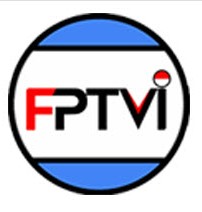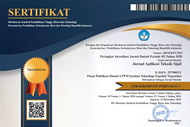Analisa Kinerja Biaya Green Pada Bangunan Utama Flour Mill Plant Berbasis Value Engineering Dan Life Cycle Cost Analysis
Abstract
In accordance with the mission of the Suistainebale Development Goals 2030, that by 2030 the new building will have a green concept of 100% and an excising building of 60%. With the Value Engineering and Life Cycle Cost Analysis methods, the application of the green concept to the Main Building of the Flour Mill Plant is used for analysis using Structural Equation Modelling – Part Least Square (SEM-PLS). The result of this study is that there are "10 factors that affect the cost performance of the Green project on the Main Building of the Flour Mill Plant", namely Project Manager Performance, Energy Efficiency, Technical Specifications, Provision of Parking Lots, Management Commitments, Water Sources, Analysis Functions, Waste Handling Systems, Selection of Alternative Materials and Energy Costs. The Value Engineering method resulted in cost savings of 14.21% of Green costs, LCCA showed a payback period with time = 3.11 years ≈ 3 years 11 months for the application of the Green concept to the main flour mill plant building.
Sesuai misi dari Suistainebale Development Goals 2030, bahwa pada tahun 2030 banguan baru berkonsep hijau sebesar 100% dan bangunan ekisting sebesar 60%. Dengan metode Value Engineering dan Life Cycle Cost Analysis, penerapan konsep green pada Bangunan Utama Flour Mill Plant digunakan analisis dengan menggunakan Structural Equation Modelling – Part Least Square (SEM-PLS). Hasil dari penelitian ini adalah terdapat “10 faktor yang berpengaruh kepada kinerja biaya pada proyek Green pada Bangunan Utama Flour Mill Plant” yaitu Project Manager Performance, Efisiensi Energi, Spesifikasi Teknis, Penyediaan Lahan Parkir, Komitmen Manajemen, Sumber Air, Fungsi Analisis, Sistem Penanganan Sampah, Pemilihan Material Alternatif dan Biaya Energi. Metode Value Engineering menghasilkan penghematan biaya sebesar 14,21% dari biaya Green, LCCA menunjukkan pembayaran kembali (Payback Period) dengan waktu = 3,11 Tahun ≈ 3 Tahun 11 Bulan untuk penerapan konsep Green pada bangunan Utama Flour Mill Plant.
Keywords
Full Text:
PDFReferences
S. N. Saajidah and I. W. Sukadana, Elastisitas permintaan gandum dan produk turunan gandum di Indonesia, vol. 13, no. 1. 2020.
A. Ebrahim and A. S. Wayal, “BIM based building performance analysis of a green office building,” Int. J. Sci. Technol. Res., vol. 8, no. 8, pp. 566–573, 2019.
B. G. Hwang, M. Shan, and E. K. Tan, “Investigating reworks in green building construction projects: Magnitude, influential factors, and solutions,” Int. J. Environ. Res., vol. 10, no. 4, pp. 499–510, 2016.
H. Bon-Gang, “Cost Premium, Performance and Improvement of Green Construction Projects,” Perform. Improv. Green Constr. Proj., pp. 103–118, 2018, doi: 10.1016/b978-0-12-815483-0.00008-9.
İ. Dinçer, “Renewable Energy Resources,” Energy Concepts Appl., pp. 185–286, 2022, doi: 10.53478/tuba.978-625-8352-00-9.ch04.
B. O. F. Knowledge, “Value Standard,” Save, no. June, 2007.
W. T. Chen, H. C. Merrett, S. Liu, N. Fauzia, and F. N. Liem, “A Decade of Value Engineering in Construction Projects,” vol. 2022, 2022.
A. E. Husin, “Implementation Value Engineering In Diaphragm Wall at High Rise Building,” vol. 8, no. 1, pp. 16–23, 2019.
A. E. Husin, “Model Aliansi Strategis Dalam Kemitraan Pemerintah dan Swasta Pada Mega Proyek Infrastruktur Berbasis Value Engineering Untuk Meningkatkan Nilai Kelayakan Proyek,” pp. 1–337, 2015.
T. C. Marrana, J. D. Silvestre, J. de Brito, and R. Gomes, “Lifecycle Cost Analysis of Flat Roofs of Buildings,” J. Constr. Eng. Manag., vol. 143, no. 6, p. 04017014, 2017, doi: 10.1061/(asce)co.1943-7862.0001290.
C. Study, N. Correia, P. Samani, and J. Gregory, “Lifecycle Cost Analysis of Prefabricated Composite and Masonry Buildings : Comparative Study,” vol. 24, no. 1, pp. 1–11, 2018, doi: 10.1061/(ASCE)AE.1943-5568.0000288.
Y. Li, H. Song, P. Sang, P. H. Chen, and X. Liu, “Review of Critical Success Factors (CSFs) for green building projects,” Build. Environ., vol. 158, pp. 182–191, 2019, doi: 10.1016/j.buildenv.2019.05.020.
A. E. Y. Al-Hosani and N. B. A. Rashid, “Conceptual framework of the critical success factors of green building towards sustainable construction in United Arab Emirates,” Proc. Int. Conf. Ind. Eng. Oper. Manag., pp. 4455–4463, 2021.
M. Gunduz and M. Almuajebh, “Critical success factors for sustainable construction project management,” Sustain., vol. 12, no. 5, 2020, doi: 10.3390/su12051990.
A. I. Imron and A. E. Husin, “Peningkatan Kinerja Biaya Berbasis Value Engineering Pada Proyek Green Hospital,” J. Apl. Tek. Sipil, vol. 19, no. 3, p. 323, 2021, doi: 10.12962/j2579-891x.v19i3.9144.
A. D. A. Dengan and K. Disarankan, “Lampiran2021PermenPUPR21,” 2021.
A. F. Kineber, I. Othman, A. E. Oke, N. Chileshe, and M. K. Buniya, “Identifying and assessing sustainable value management implementation activities in developing countries: The case of Egypt,” Sustain., vol. 12, no. 21, pp. 1–20, 2020, doi: 10.3390/su12219143.
T. Karolina, A. E. Husin, and B. Susetyo, “Analysis of Key Success Factors on the Improvement Façade Performance of High-Rise Hotels Based on Green Building and Value Engineering Using the RII …,” Academia.Edu, vol. 8, no. February, pp. 569–577, 2021, [Online]. Available: https://www.academia.edu/download/65886310/IJRR071.pdf.
Ariadi, “Faktor Kunci Sukses Penerapan Value Engineering (Ve) Pada Bangunan Gedung Di Indonesia,” Rekayasa Sipil, vol. 6, no. 2, pp. 77–85, 2017.
Z. Zhan et al., “BIM-Based Green Hospital Building Performance Pre-Evaluation: A Case Study,” Sustain., vol. 14, no. 4, pp. 1–21, 2022, doi: 10.3390/su14042066.
S. K. Fuller and S. R. Petersen, LCCosting Manual for the Federal Energy Management Program, no. 135. 1996.
E. Plebankiewicz, “Model of Predicting Cost Overrun in Construction Projects,” 2018, doi: 10.3390/su10124387.
M. Sarstedt, “The Great Facilitator,” Gt. Facil., no. March, 2019, doi: 10.1007/978-3-030-06031-2.
J. F. Hair, M. Sarstedt, L. Hopkins, and V. G. Kuppelwieser, “Partial least squares structural equation modeling (PLS-SEM): An emerging tool in business research,” Eur. Bus. Rev., vol. 26, no. 2, pp. 106–121, 2014, doi: 10.1108/EBR-10-2013-0128.
DOI: http://dx.doi.org/10.12962%2Fj2579-891X.v21i1.14988
Refbacks
- There are currently no refbacks.

Jurnal Aplikasi Teknik Sipil by Pusat Publikasi Ilmiah LPPM Institut Teknologi Sepuluh Nopember is licensed under a Creative Commons Attribution-ShareAlike 4.0 International License
Based on work at https://iptek.its.ac.id/index.php/jats




